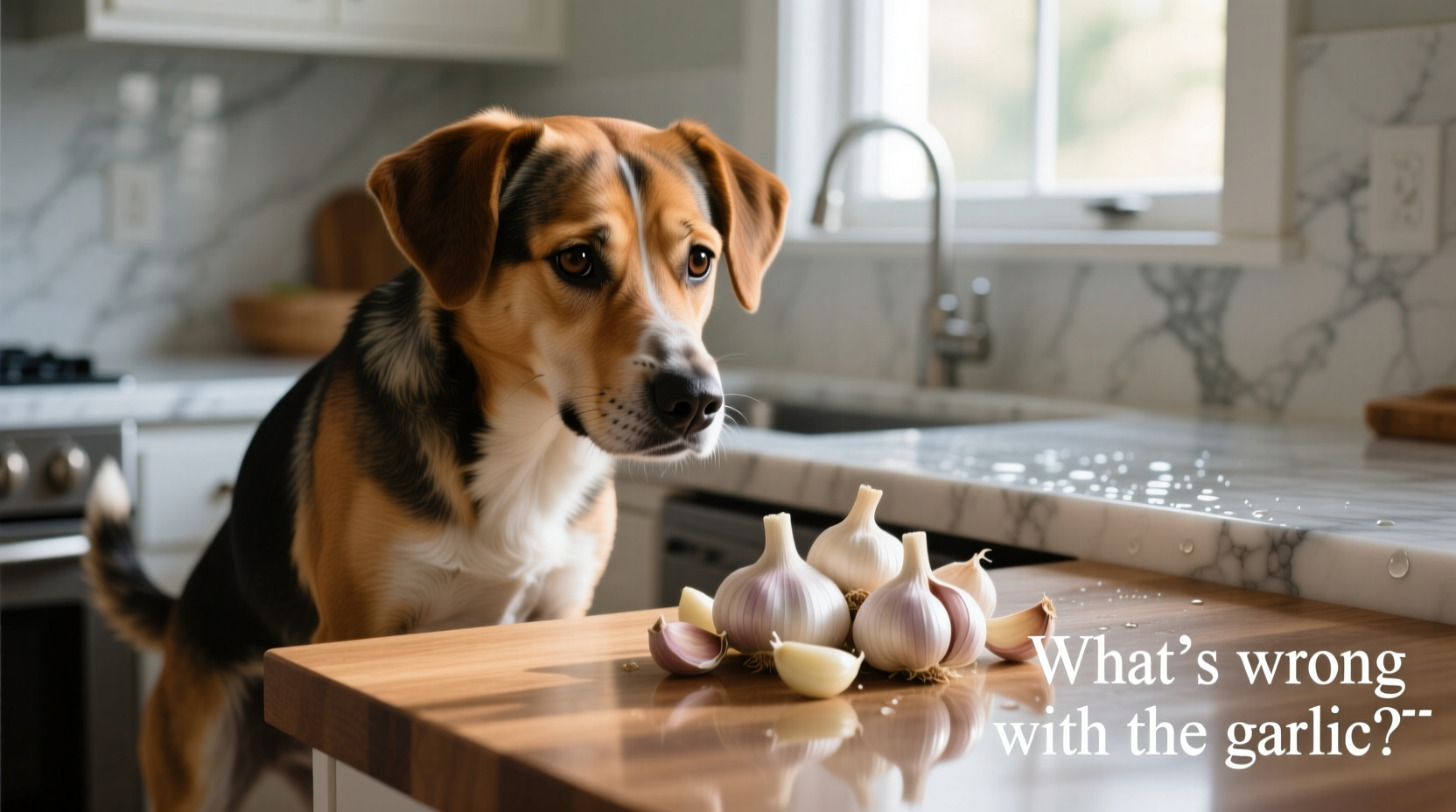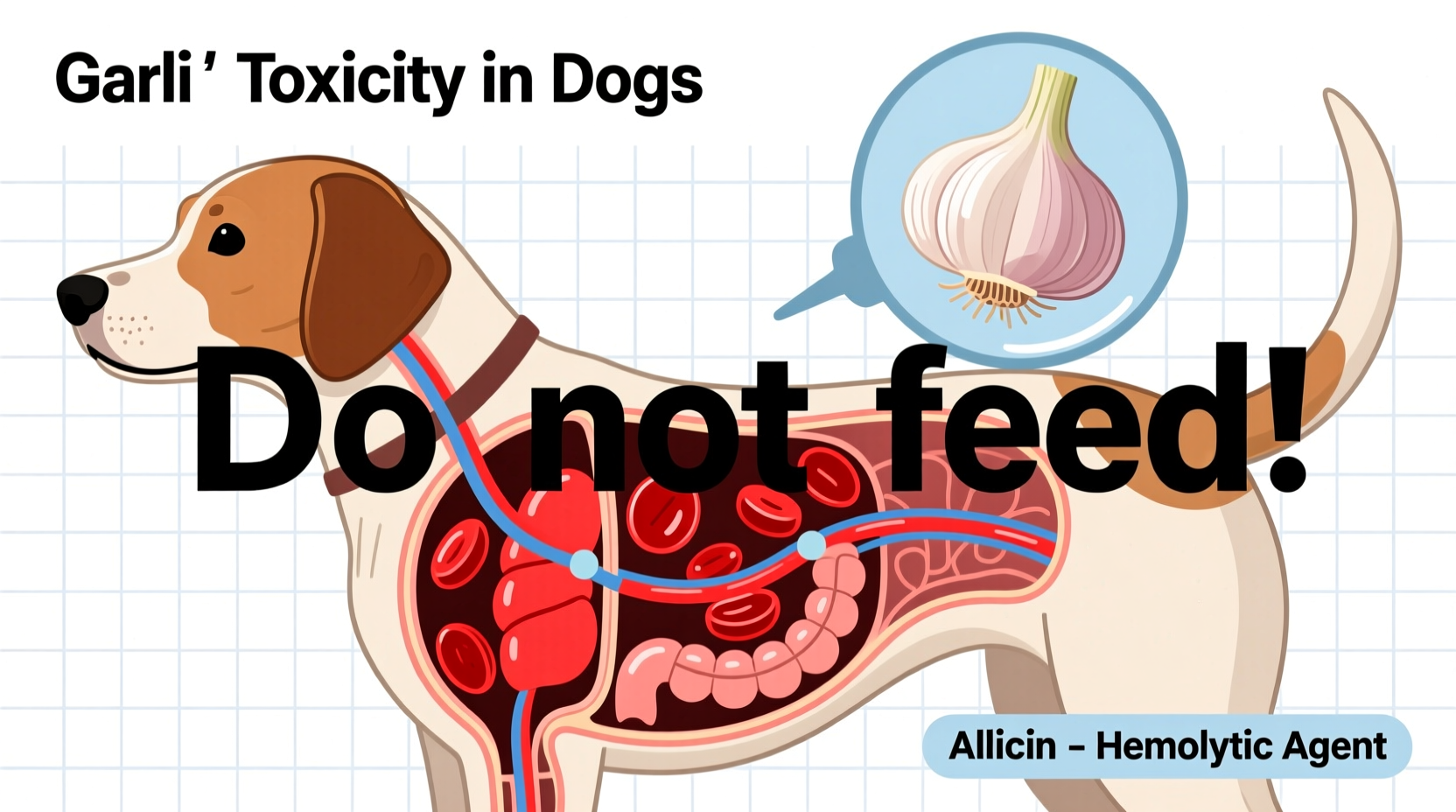Garlic is toxic to dogs and can cause life-threatening hemolytic anemia by damaging red blood cells. Even small amounts—just one clove for a medium-sized dog—can trigger symptoms like weakness, vomiting, and dark urine within 24-72 hours. Immediate veterinary care is essential if your dog consumes garlic.
What to Do If Your Dog Ate Garlic: Urgent Action Steps
If your dog accidentally consumed garlic, time is critical. Unlike humans, dogs lack the enzyme to safely process thiosulfates found in garlic and other Allium plants. These compounds cause oxidative damage to red blood cells, leading to hemolytic anemia—a potentially fatal condition.
Follow these steps immediately:
- Contact your veterinarian or pet poison control (ASPCA Animal Poison Control: 888-426-4435)
- Note the amount consumed and time of ingestion
- Do not induce vomiting without professional guidance
- Bring packaging or plant samples to help identify the specific Allium compound
According to the Cornell University College of Veterinary Medicine, symptoms may not appear for 24-72 hours, making early intervention crucial even if your dog seems fine initially.

Why Garlic Is Dangerous: The Science Explained
Garlic contains N-propyl disulfide, a compound that oxidizes hemoglobin in dogs' red blood cells. This creates Heinz bodies—abnormal structures that make red blood cells fragile and prone to rupture. The resulting hemolytic anemia reduces oxygen delivery throughout the body.
| Garlic Form | Toxic Dose for 20lb Dog | Risk Level |
|---|---|---|
| Fresh garlic cloves | 1-2 cloves | High |
| Garlic powder | 1/2 teaspoon | Extreme |
| Garlic supplements | 1 capsule | Severe |
| Garlic in food | 1 tablespoon | Moderate-High |
Research published in American Journal of Veterinary Research shows that garlic powder is approximately 5 times more concentrated than fresh garlic, making it especially dangerous. Japanese breeds like Shiba Inus and Akita may be more susceptible due to genetic factors affecting red blood cell structure.
Symptoms Timeline: What to Watch For
Garlic toxicity symptoms develop gradually, which is why many owners don't connect the illness to previous garlic exposure. Understanding this progression helps with early detection:
- 0-24 hours: Vomiting, diarrhea, abdominal pain (often mistaken for general stomach upset)
- 24-48 hours: Lethargy, pale gums, rapid breathing (signs of developing anemia)
- 48-72 hours: Dark urine (hemoglobinuria), jaundice, collapse (critical stage requiring immediate intervention)
The University of Pennsylvania School of Veterinary Medicine reports that severe cases can require blood transfusions and intensive care. Even dogs that recover may experience long-term organ damage from oxygen deprivation.
Common Misconceptions About Garlic and Dogs
Despite widespread myths, there's no safe amount of garlic for dogs. Let's address dangerous misconceptions:
- "Small amounts are medicinal" - No scientific evidence supports garlic as a safe flea repellent or health supplement for dogs. The American Kennel Club explicitly warns against this practice.
- "Cooking removes toxicity" - Heat doesn't destroy thiosulfates; cooked garlic remains dangerous.
- "My dog ate garlic and was fine" - Individual tolerance varies, but repeated exposure increases risk. One safe incident doesn't guarantee future safety.
Prevention Strategies for Garlic Exposure
Protect your dog by implementing these practical measures:
- Secure kitchen areas - Store garlic and onions in closed cabinets away from countertops
- Check food labels - Many commercial dog foods and treats contain garlic powder as a flavor enhancer
- Educate family members - Especially children who might share "people food" with pets
- Be cautious with leftovers - Common culprits include garlic bread, pizza, pasta sauces, and seasoned meats
According to the ASPCA Animal Poison Control Center, calls about garlic and onion toxicity increased by 35% between 2020-2023, often involving well-meaning owners who didn't realize common foods posed risks.
Safe Flavor Alternatives for Dogs
If you want to enhance your dog's food with safe flavors, consider these veterinarian-approved options:
- Parsley - Fresh, in small amounts (antioxidant properties)
- Basil - Anti-inflammatory benefits
- Cinnamon - In tiny amounts (may help regulate blood sugar)
- Carrots - Natural sweetness with dental benefits
Always introduce new foods gradually and consult your veterinarian before making dietary changes, especially for dogs with health conditions.
Frequently Asked Questions
How much garlic is toxic to dogs?
As little as 15-30 grams of garlic per kilogram of body weight can cause toxicity. For a 20-pound dog, this equals approximately one clove of fresh garlic. Garlic powder is significantly more concentrated and dangerous—just 1/2 teaspoon can be toxic.
Can dogs recover from garlic poisoning?
Yes, with prompt veterinary treatment, most dogs recover fully. Recovery typically takes 3-7 days with supportive care. Severe cases requiring blood transfusions may take several weeks for complete recovery. Early intervention dramatically improves outcomes.
Is cooked garlic safe for dogs?
No, cooking does not eliminate garlic's toxicity. The harmful thiosulfate compounds remain stable through cooking processes. Both raw and cooked garlic pose equal risks to dogs.
What should I do if my dog ate garlic bread?
Contact your veterinarian immediately. Garlic bread contains both garlic and butter/oil, which can cause additional gastrointestinal issues. Note how much your dog consumed and when, as this information helps determine appropriate treatment.
Are some dog breeds more sensitive to garlic?
Yes, Japanese breeds including Shiba Inus and Akitas appear more susceptible to garlic toxicity due to genetic differences in red blood cell structure. However, all dog breeds can develop hemolytic anemia from garlic exposure regardless of breed.











 浙公网安备
33010002000092号
浙公网安备
33010002000092号 浙B2-20120091-4
浙B2-20120091-4